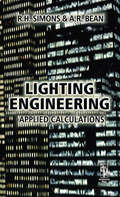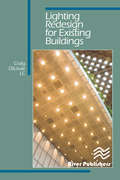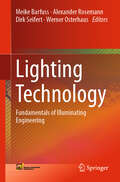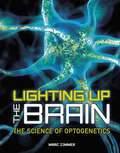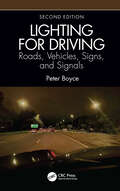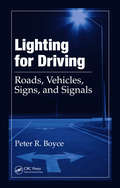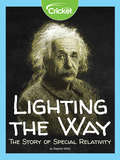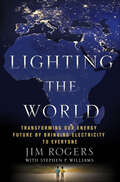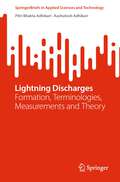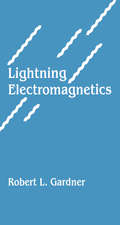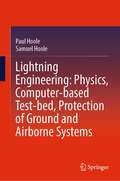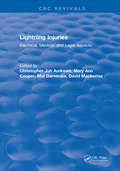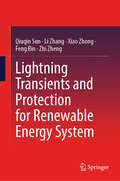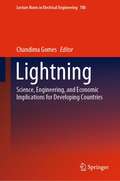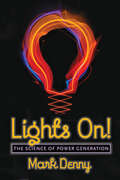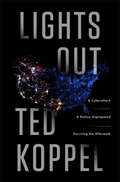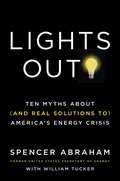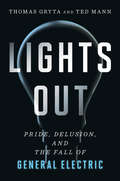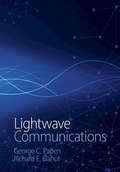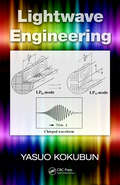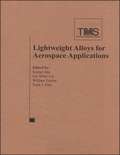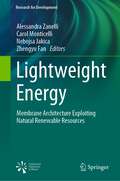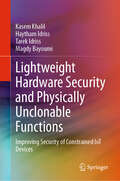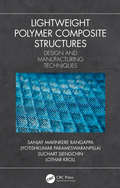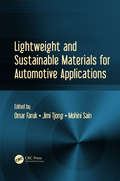- Table View
- List View
Lighting Engineering: Applied Calculations
by R. H. Simons A.R. Bean'Lighting Engineering: Applied Calculations' describes the mathematical background to the calculation techniques used in lighting engineering and links them to the applications with which they are used. The fundamentals of flux and illuminance, colour, measurement and optical design are covered in detail. There are detailed discussions of specific applications, including interior lighting, road lighting, tunnel lighting, floodlighting and emergency lighting. The authors have used their years of experience to provide guidance for common mistakes and useful techniques including worked examples and case studies.The last decade has seen the universal application of personal computers to lighting engineering on a day-to-day basis. Many calculations that were previously impracticable are therefore now easily accessible to any engineer or designer who has access to an appropriate computer program. However, a grasp of the underlying calculation principles is still necessary in order to utilise these technologies to the full. Written by two of the leading authorities on this subject, 'Lighting Engineering' is essential reading for practising lighting engineers, designers and architects, and students in the field of lighting.
Lighting Redesign for Existing Buildings
by Craig DiLouieIn Lighting Redesign for Existing Buildings, veteran journalist and educator Craig DiLouie identifies opportunities to both save energy and improve lighting performance in existing buildings. The book outlines the decision-making process behind whether to retrofit or redesign an existing lighting system, describes basic lighting design techniques and how to evaluate lighting equipment, details lighting legislation and energy codes, identifies advanced lighting strategies, and describes the role planned maintenance can play in saving energy and ensuring long-term performance. Readers will gain in-depth insight into assessing and capturing their opportunities with better lighting.
Lighting Technology: Fundamentals of Illuminating Engineering
by Alexander Rosemann Dirk Seifert Meike Barfuss Werner OsterhausLighting Technology offers a comprehensive and complete overview on the field. It is a translation of the 5th edition of the German textbook "Beleuchtungstechnik" by Huss Media, Berlin. It introduces the fundamentals of lighting technology and discusses concepts for good lighting and daylighting design. This book is widely used in German universities and has already helped generations of students to graduate and kick-off their professional career in the field of lighting. Valuable contributions to this book came from a group of well-established lighting experts consisting of academics and design professionals. It covers the following key aspects: Fundamentals of Lighting Technology, Light Sources and Auxiliary Devices, Luminaires, Lighting Control, Illumination with Daylight, Illumination Systems for Interior Spaces, and Illumination Systems for Exterior Spaces. The motivation for this book was initiated in National lighting associations including but not limited to the German LiTG, the Dutch NSVV andthe Intelligent Lighting Institute ILI of Eindhoven University of Technology with the goal to transfer expert knowledge to everybody interested in broadening his knowledge in the field of lighting technology and illuminating engineering, like university students, researchers and lighting designers. It is suitable to serve as a supportive source of knowledge and reference when studying lighting technology or pursuing a professional qualification as ELE (European Lighting Expert) offered by ELEA, the European Lighting Expert Association. The book provides all the knowledge necessary for working on and successfully completing innovative lighting projects.
Lighting Up the Brain: The Science of Optogenetics
by Marc ZimmerWhat if neuroscientists could look inside the human brain and watch individual brain cells send signals to one another? What if they could then control these brain cells to direct thoughts and actions? This may sound like science fiction, but it's actually a scientific revolution called optogenetics. Neuroscientists would like to use this new technology on human brains to uncover secrets about how the brain processes information and drives human behavior. Doctors hope to use optogenetics to restore sight and to treat Alzheimer's disease, Parkinson's disease, depression, and other debilitating or deadly health problems. Discover how the innovative work of leaders in the field is poised to radically transform science, medicine, and human health.
Lighting for Driving: Roads, Vehicles, Signs, and Signals
by Peter BoyceVehicle, road, sign, and signal lighting are provided to enable drivers to reach their destinations quickly and safely. However, the attention given to how these forms of lighting function is likely to change as new technology is introduced and understanding of ergonomics and human factors improves. Lighting for Driving: Roads, Vehicle, Signs and Signals, Second Edition shows the crucial role lighting plays in road safety and examines how it could be used more effectively. With light-emitting diodes (LEDs) becoming the lighting source of choice for transport planners and vehicle designers, this book integrates information on road lighting, vehicle lighting, signs, and signals in one handy volume.International in scope and updated for this new edition, this book features lighting examples from the USA, the UK, France, Germany, The Netherlands, Denmark, Sweden, Norway, Finland, Japan, Australia, and New Zealand. Lighting in common vehicle types including cars, vans, trucks, and motorcycles is covered as well as the visibility of pedestrians and cyclists to drivers. Coverage extends to road lighting, traffic markings, vehicle designs, and internal lighting and weather conditions. Now fully updated, a final chapter looks at the future of lighting in relation to driving. The book will help the reader to understand how lighting systems on roads and vehicles work by explaining the thinking and scientific reasoning behind various forms of lighting and analyzing their contribution to the driver’s understanding of real and potential road hazards.This book will be an ideal read for ergonomists and engineers engaged in transport and road engineering, transport planners, civil engineers, vehicle designers, and electrical engineers.
Lighting for Driving: Roads, Vehicles, Signs, and Signals
by Peter R. BoyceIntegrates Vehicle, Signal, and Road Lighting into a Unified SystemMany people drive many miles after dark and rely on lighting to help them gather information about the road ahead and the presence and intentions of other people on and near the road. With new technology on the industry's horizon, Lighting for Driving: Roads, Vehicle, Signs and Sign
Lighting the Way: The Story of Special Relativity
by Stephen WhittWhat is a light beam? What are photon particles? What are all things made of? These are questions young Einstein asked himself; questions that would change our world forever. Travel along with young Einstein to learn about his discoveries, still in motion today!
Lighting the World: Transforming Our Energy Future by Bringing Electricity to Everyone
by Jim Rogers Stephen P. WilliamsA former power company executive “makes his provocative case for powering up the Third World” (Discover).Without electricity, everything is harder. Imagine no cell phones, refrigerators, kitchen lights, or radios. Imagine having to finish all the day’s tasks—cooking, working, cleaning—before the sun goes down. Your children couldn’t do homework; you couldn’t read. It seems unthinkable today, yet this is how a staggering number of people on Earth still live. But Jim Rogers believes that can soon change—transforming not only people’s daily lives, but also their hopes for the future.In Lighting the World, Rogers describes how an international coalition can come together to secure financing, spearhead the newest and cleanest technologies, and work with the governments, entrepreneurs, and NGOs already on the ground to ensure that everyone has access to a steady and reliable supply of power. In today’s competitive world, Rogers believes, that shouldn’t be an accidental privilege, but a fundamental human right.Praise for Lighting the World“A passionate, but not ideological, argument that offers a practical approach to solving real problems.” —Kirkus Reviews“An enthusiastic account and a great starting point for readers curious about sustainable, worldwide electricity.” —Library Journal“In Lighting the World, Jim Rogers treats us to two books in one: a gripping journey around the dramatic world of energy for the poor combined with a fascinating account of what it takes to run and innovate a major U.S. utility.” —Dan Kammen, Professor of Energy, Energy and Resources Group & Goldman School of Public Policy, University of California
Lightning Discharges: Formation, Terminologies, Measurements and Theory (SpringerBriefs in Applied Sciences and Technology)
by Pitri Bhakta Adhikari Aashutosh AdhikariThis book highlights the basic information about lightning. It is an unpredictable disaster, and it is an extremely complex electrical discharge phenomenon. A complete theory of lightning does not exist till now. This book elaborates on the basic formation of lightning, terminologies related to lightning, and the preliminary lightning theory. There are different types of lightning, such as cloud flashes, ground flashes (both positive and negative), and air discharges. This book explains some unusual events related to lightning and inspects innovation. This book also describes the measurement of electric and magnetic fields generated by lightning, which are the basic parameters for lightning fundamentals.
Lightning Electromagnetics
by Robert GardnerA survey of theoretical and experimental research, this book covers all areas of lightning phenomenology. The four sections cover models of fundamental lightning processes, propagation of lightning-induced signals, measurement of lightning parameters, and lightning interaction with systems. The book provides an excellent review of the use of models to support remote sensing efforts. It includes data on high-frequency radiated fields for lightening and an overview of the data available in the frequency and time domains for lightning. The book also presents spectoral and temporal characteristics of lightning in the VHF-UHF frequency range and uses photographic and electromagnetic measurements to examine how lighting chooses a strike point.
Lightning Engineering: Physics, Computer-based Test-bed, Protection of Ground and Airborne Systems
by Paul Hoole Samuel HooleThis book gives a contemporary and comprehensive overview of the physics of lightning and protection systems, based on nearly 40 years of research, teaching, and consultancy work in this area. The book begins with an overview of the climatology of lightning and electric storms, as well as giving insight into lightning discharge from the preliminary discharges or processes such as corona, stepped leader, and subsequent return strokes, including the important submicrosecond threats and continuous current. The subsequent chapters present measures of lightning threat analysis to aircraft and electric power systems, protection measures to be used in high-voltage to low-voltage computer and communication systems, as well as to commercial and domestic buildings. The book discusses challenges posed by the submicrosecond lighting current changes and climate change to present and future high-voltage apparatus and structures (including carbon composite aircraft and new buildings) exposed to lightning strikes. Including worked examples, illustrations, and detailed analysis, Lightening Engineering will be of interest to electrical engineers, as well as researchers and graduate students.
Lightning Injuries: Electrical, Medical, and Legal Aspects
by Christopher Joh AndrewsLightning Injuries: Electrical, Medical, and Legal Aspects presents a thorough examination of injuries inflicted by lightning strikes. The expertise of acknowledged world authorities from three continents have been brought together to create this truly remarkable volume. Lightning Injuries: Electrical, Medical, and Legal Aspects begins with a short historical review featuring a discussion of the physics of lightning phenomena and the aspects of electrical circuit theory. This review provides the background for following chapters, which address topics such as the epidemiology of lightning injury, the pathogenesis of the features of lightning injury, the clinical aspects of managing patients with lightning injury, and lightning injury mediated by communications systems (including telephones). The book also describes the problem of finding protection against lightning strikes and the issues that arise in legal liability as a result of lightning strikes. The book is written for a diverse audience and includes material that makes it appropriate for all professionals in medical, legal, and technical fields. Never before has such a comprehensive collation of related facets of lightning injury been published within a single volume.
Lightning Transients and Protection for Renewable Energy System
by Li Zhang Xiao Zhong Qiuqin Sun Feng Bin Zhi ZhengThis book is dedicated to lightning transients and protection for renewable energy systems, including both wind and solar energy. In addition to the formation mechanism of lightning transients, the practical engineering application has also been addressed. This book is comprehensive and covers the methodology of electromagnetic transient modelling, electromagnetic coupling for PV system, lightning protection design, testing and evaluation. This book is particularly suitable for readers interested in lightning phenomena and renewable energy systems. It would benefit researchers, engineers and graduate students in the fields of electrical engineering, renewable energy, computational electromagnetism, etc.
Lightning: Science, Engineering, and Economic Implications for Developing Countries (Lecture Notes in Electrical Engineering #780)
by Chandima GomesThis book highlights the essential theoretical and practical aspects of lightning, lightning protection, safety and education. Additionally, several auxiliary topics that are required to understand the core themes are also included. The main objective of the contents is to enlighten the scientists, researchers, engineers and social activists (including policy makers) in developing countries regarding the key information related to lightning and thunderstorms. A majority of developing countries are in tropics where the lightning characteristics are somewhat different from those in temperate regions. The housing structures and power/communication networks, and human behavioural patterns(that depends on socio-economic parameters) in these countries are also different from those in the developed world. As the existing books on similar themes address only those scenarios in developed countries, this book serves a vast spectrum of readership in developing world who seek knowledge in the principles of lightning and a practical guidance on lightning protection and safety education.
Lights On!: The Science of Power Generation
by Mark DennyWatt’s up? A reader-friendly introduction to all things power.Power generation is a relatively recent concern because humans had little need for sustained power until the dawn of the Industrial Revolution. Today, modern civilization is wholly dependent on the production and distribution of power. Without it, our way of life would be extinguished.In Lights On!, Mark Denny reveals the mysterious world of power generation. He takes us on a fun tour, examining the nature of energy, tracing the history of power generation, explaining the processes from production through transmission to use, and addressing questions that are currently in the headlines, such as:• Is natural gas the best alternative energy source in the near term? • Could solar power be the answer to all our problems? • Why is nuclear power such a hard sell, and are the concerns valid?Devoting individual chapters to each of the forms of power in use today—electrical, coal, oil and natural gas, hydro, nuclear, and solar—Denny explains the pros and cons of each, their availability worldwide, and which are in dwindling supply. Making clear that his approach is that of "a scientist and engineer, not a politician or businessman," Denny addresses environmental concerns by providing information to help readers understand the science and engineering of power generation so they can discuss contemporary energy issues from an informed perspective. For those who wish to delve deeper into the science, a technical appendix provides estimations for a variety of power generators.Anyone who is interested in how energy works and how it is transformed to power our lives will get a charge out of Lights On!
Lights Out
by Ted KoppelIn this tour de force of investigative reporting, Ted Koppel reveals that a major cyberattack on America's power grid is not only possible but likely, that it would be devastating, and that the United States is shockingly unprepared. Imagine a blackout lasting not days, but weeks or months. Tens of millions of people over several states are affected. For those without access to a generator, there is no running water, no sewage, no refrigeration or light. Food and medical supplies are dwindling. Devices we rely on have gone dark. Banks no longer function, looting is widespread, and law and order are being tested as never before. It isn't just a scenario. A well-designed attack on just one of the nation's three electric power grids could cripple much of our infrastructure--and in the age of cyberwarfare, a laptop has become the only necessary weapon. Several nations hostile to the United States could launch such an assault at any time. In fact, as a former chief scientist of the NSA reveals, China and Russia have already penetrated the grid. And a cybersecurity advisor to President Obama believes that independent actors--from "hacktivists" to terrorists--have the capability as well. "It's not a question of if," says Centcom Commander General Lloyd Austin, "it's a question of when." And yet, as Koppel makes clear, the federal government, while well prepared for natural disasters, has no plan for the aftermath of an attack on the power grid. The current Secretary of Homeland Security suggests keeping a battery-powered radio.In the absence of a government plan, some individuals and communities have taken matters into their own hands. Among the nation's estimated three million "preppers," we meet one whose doomsday retreat includes a newly excavated three-acre lake, stocked with fish, and a Wyoming homesteader so self-sufficient that he crafted the thousands of adobe bricks in his house by hand. We also see the unrivaled disaster preparedness of the Mormon church, with its enormous storehouses, high-tech dairies, orchards, and proprietary trucking company - the fruits of a long tradition of anticipating the worst. But how, Koppel asks, will ordinary civilians survive?With urgency and authority, one of our most renowned journalists examines a threat unique to our time and evaluates potential ways to prepare for a catastrophe that is all but inevitable.
Lights Out!: Ten Myths About (and Real Solutions To) America's Energy Crisis
by Spencer Abraham William Guise TuckerIn this timely book, former Secretary of Energy Spencer Abraham debunks the myths that warp our current debate over energy, and offers new solutions to the real problems we face in America. Drawing on the very latest thinking from experts in industry and academia, and his own experiences running America's Energy Department, he proposes a fresh approach to meeting our daunting energy threats. This book effectively answers how America and the world can overcome the challenges of rising global energy demand, geopolitical disruptions of the energy marketplace, and the environmental impact of producing and using energy. What emerges is a pragmatic energy strategy that calls for blending a variety of energy sources including nuclear, clean coal, solar, wind, and natural gas with a more determined effort at improving energy efficiency through the deployment of smart energy grids and buildings, to help meet our challenges while preserving our economy and environment. Coming in the midst of a national debate about global warming, energy dependence and rising energy prices and rich with anecdotes from the author's service in the Senate and cabinet, this book is a clarion call that will help shape our energy future.
Lights Out: Pride, Delusion, and the Fall of General Electric
by Thomas Gryta Ted MannHow could General Electric—perhaps America&’s most iconic corporation—suffer such a swift and sudden fall from grace? This is the definitive history of General Electric&’s epic decline, as told by the two Wall Street Journal reporters who covered its fall. Since its founding in 1892, GE has been more than just a corporation. For generations, it was job security, a solidly safe investment, and an elite business education for top managers. GE electrified America, powering everything from lightbulbs to turbines, and became fully integrated into the American societal mindset as few companies ever had. And after two decades of leadership under legendary CEO Jack Welch, GE entered the twenty-first century as America&’s most valuable corporation. Yet, fewer than two decades later, the GE of old was gone. Lights Out examines how Welch&’s handpicked successor, Jeff Immelt, tried to fix flaws in Welch&’s profit machine, while stumbling headlong into mistakes of his own. In the end, GE&’s traditional win-at-all-costs driven culture seemed to lose its direction, which ultimately caused the company&’s decline on both a personal and organizational scale. Lights Out details how one of America&’s all-time great companies has been reduced to a cautionary tale for our times.
Lightwave Communications
by Richard E. Blahut George C. PapenThis pioneering, course-tested text is the first to combine communications theory with the physics of optical communications. Comprehensive and rigorous, it brings together an in-depth treatment of the physical characteristics of the guided lightwave channel with the study of modern methods of algorithmic-based communication in time and space. The many different levels at which a lightwave communication signal can be described are integrated to provide a unified explanation of how a commonplace bit stream is transformed into a physical lightwave, how that lightwave travels through an optical fiber, and how it is then transformed back into the bit stream. Background fundamentals such as linear systems and electromagnetics are explained in relation to modern topics such as channel models, encoding, modulation and interference, and end-of-chapter problems are provided throughout. This is an essential text for students taking courses on optical communications, as well as researchers and professionals working in the area.
Lightwave Engineering (Optical Science and Engineering)
by Yasuo KokubunSuitable as either a student text or professional reference, Lightwave Engineering addresses the behavior of electromagnetic waves and the propagation of light, which forms the basis of the wide-ranging field of optoelectronics. Divided into two parts, the book first gives a comprehensive introduction to lightwave engineering using plane wave and then offers an in-depth analysis of lightwave propagation in terms of electromagnetic theory. Using the language of mathematics to explain natural phenomena, the book includes numerous illustrative figures that help readers develop an intuitive understanding of light propagation. It also provides helpful equations and outlines their exact derivation and physical meaning, enabling users to acquire an analytical understanding as well. After explaining a concept, the author includes several problems that are tailored to illustrate the explanation and help explain the next concept. The book addresses key topics including fundamentals of interferometers and resonators, guided wave, optical fibers, and lightwave devices and circuits. It also features useful appendices that contain formulas for Fourier transform, derivation of Green's theorem, vector algebra, Gaussian function, cylindrical function, and more. Ranging from basic to more difficult, the book’s content is designed for easily adjustable application, making it equally useful for university lectures or a review of basic theory for professional engineers.
Lightweight Alloys for Aerospace Applications
by Nack J. Kim Kumar Jata Eui Whee Lee William FrazierThis proceedings volume from the 2001 TMS Annual Meeting & Exhibition covers advances made in the area of scientific understanding of technological application of lightweight alloys. Papers focus on fundamental science as well as application and concentrate on scientific advances in aluminum, magnesium, titanium, and beryllium alloys and their composites. Processing, structure-property relationship, failure mechanisms, and advanced joining themes are also discussed.
Lightweight Energy: Membrane Architecture Exploiting Natural Renewable Resources (Research for Development)
by Alessandra Zanelli Carol Monticelli Nebojsa Jakica Zhengyu FanThis book explores membrane materials as a means of translating natural and renewable resources into a more flexible, dynamic, and reactive architectural skin. It represents the first time that energy-saving design has been addressed systematically in relation to lightweight building systems and tensile membranes. Understanding of the energetic behavior of membranes and foils used as a building envelope is a fundamental theme, as it is the integration of flexible photovoltaics in membranes, as well as the exploitation of water and wind resources. A theoretical, methodological framework for consciously designing the membrane life cycle is presented. The authors cross-cut and combine exploration of climate-based design methodology and life cycle thinking strategies. Both active and passive systems are investigated, referring to alternative productive resources like sun, wind, and water. Case studies are brought forward in the book’s second half, highlighting energy lightness for an increasingly dematerialized architecture and addressing inherent issues. Four main research and development paths are presented, the first two focusing on advancements in façade materials and Photovoltaic systems applicable to membrane architecture, the third referring to fog and dew harvesting and the fourth dealing with the future frontier of flexible transparency and designs for well-being through a passive solar system.
Lightweight Hardware Security and Physically Unclonable Functions: Improving Security of Constrained IoT Devices
by Magdy Bayoumi Kasem Khalil Haytham Idriss Tarek IdrissThis book discusses the design and evaluation of Physically Unclonable Functions (PUFs) that are suitable for securing highly energy constrained devices, while at the same time classifying the many applications and devices that would benefit from various PUF designs. The authors provide a comprehensive study of the various approaches that are used to mitigate PUFs’ shortcomings, while at the same time highlighting those that are most efficient. Coverage also includes state-of-the-art approaches to designing PUFs with high resilience to machine learning attacks and hardware implementation of area-efficient and high performing PUF architectures. The authors also classify different IoT applications and devices, depending on their security needs and limitations, offering a new perspective on how different PUF designs fit in the overall scope of IoT security.
Lightweight Polymer Composite Structures: Design and Manufacturing Techniques
by Sanjay Mavinkere Rangappa, Jyotishkumar Parameswaranpillai, Suchart Siengchin, and Lothar KrollThis book provides a comprehensive account of developments in the area of lightweight polymer composites. It encompasses design and manufacturing methods for the lightweight polymer structures, various techniques, and a broad spectrum of applications. The book highlights fundamental research in lightweight polymer structures and integrates various aspects from synthesis to applications of these materials. Features Serves as a one stop reference with contributions from leading researchers from industry, academy, government, and private research institutions across the globe Explores all important aspects of lightweight polymer composite structures Offers an update of concepts, advancements, challenges, and application of lightweight structures Current status, trends, future directions, and opportunities are discussed, making it friendly for both new and experienced researchers.
Lightweight and Sustainable Materials for Automotive Applications
by Omar Faruk Jimi Tjong Mohini SainAutomotive manufacturers are required to decrease CO2 emissions and increase fuel economy while assuring driver comfort and safety. In recent years, there has been rapid development in the application of lightweight and sustainable materials in the automotive industry to help meet these criteria. This book provides critical reviews and the latest research results of various lightweight and sustainable materials in automotive applications. It discusses current applications and future trends of lightweight materials in the automotive area. While there are a few books published mainly focusing on automotive applications of metallic lightweight materials, to date there is no available book focusing on a broad spectrum of lightweight materials, including metal, plastic, composites, bio-fiber, bio-polymer, carbon fiber, glass fiber, nanomaterials, rubber materials, and foaming materials, as this work does. The book also includes case studies of commercial lightweight automotive parts from sustainable lightweight materials, providing an invaluable resource to those involved in this in-demand research and commercialization area.
